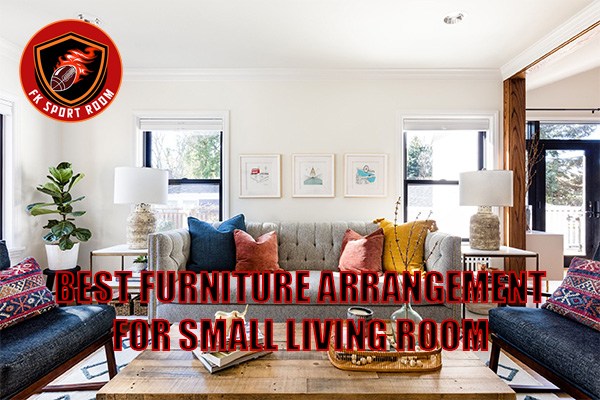Blogs
Best Furniture Arrangement for Small Living Room: Smart, Stylish & Functional Ideas
Designing a small living room can feel tricky—you want comfort, flow, and style without making the space feel cramped. The good news? With the right layout, furniture choices, and design tricks, your compact living room can feel bigger, brighter, and more welcoming.
In this guide, we’ll explore the best furniture arrangement for small living room, share layout ideas, weigh pros and cons, and offer styling tips with paint colors, lighting, rugs, and furniture.

Why furniture arrangement matters in small living rooms
The way you arrange furniture can:
- Make a room feel larger and more open
- Improve traffic flow for daily living
- Highlight focal points like fireplaces, windows, or TVs
- Create a cozy, inviting atmosphere
Even a tiny living room can feel spacious with the right arrangement strategy.
Best furniture arrangement ideas for small living rooms
Floating furniture layout
Why it works:
Instead of pushing sofas against walls, pull them slightly forward to create breathing space. This layout makes the room feel less boxed-in.
Tips to style:
- Furniture: Choose a compact sofa with slim arms and pair it with lightweight accent chairs.
- Lighting: Use floor lamps behind the sofa for a layered glow.
- Rugs: Anchor the furniture with a rug large enough so at least the front legs of each piece sit on it.
L-shaped sofa arrangement
Why it works:
An L-shaped sectional maximizes seating while defining the room. It works especially well if your living room is part of an open-plan layout.
Tips to style:
- Furniture: Choose a sectional with storage or a pull-out bed for multi-functionality.
- Lighting: Add pendant lighting above the coffee table for balance.
- Rugs: Go for a rectangular rug that mirrors the shape of the sofa.
Symmetrical arrangement
Why it works:
Placing two identical chairs opposite a sofa creates balance, making the room feel organized and inviting.
Tips to style:
- Furniture: Use matching side tables to enhance symmetry.
- Lighting: Place identical table lamps on each side for harmony.
- Rugs: A centered rug with a bold pattern ties the look together.
Corner arrangement
Why it works:
In very small spaces, tucking furniture into corners maximizes open floor space. It keeps the room feeling uncluttered.
Tips to style:
- Furniture: Opt for a loveseat or apartment-sized sofa.
- Lighting: Use wall sconces instead of floor lamps to save space.
- Rugs: A round rug can soften corners and make the space feel more fluid.
Floating chairs with accent tables
Why it works:
If your living room is too narrow for a large sofa, floating two or three chairs around a small table keeps things light and flexible.
Tips to style:
- Furniture: Pick armless or slipper chairs to keep the profile slim.
- Lighting: Layer lighting with a mix of floor lamps and overhead fixtures.
- Rugs: A small rug under the chairs adds definition without crowding.
Pros and cons of different arrangements
Pros:
- Floating layouts: Feel airy and flexible
- L-shaped sofas: Provide maximum seating
- Symmetry: Creates harmony and balance
- Corner layouts: Save space in tiny rooms
- Chair clusters: Allow versatility and easy movement
Cons:
- Floating layouts: Require more floor space to work well
- L-shaped sofas: Can overwhelm very narrow rooms
- Symmetry: Might feel too formal for casual spaces
- Corner layouts: Can limit focal points
- Chair clusters: Offer less lounging comfort than sofas
Styling tips – Matching furniture arrangement with paint colors
Your paint color sets the mood for your small living room. Pair it thoughtfully with furniture placement for maximum impact.
Light neutrals (White, cream, beige)
- Furniture arrangement: Floating layouts shine against light walls.
- Furniture: Soft beige or grey sofas keep the look airy.
- Lighting: Warm LED lights prevent the room from feeling stark.
- Rugs: Textured rugs in natural fibers (jute, wool) add depth.
Soft grey walls
- Arrangement: L-shaped sectionals look modern and grounded.
- Furniture: Charcoal or navy sofas provide contrast.
- Lighting: Metallic floor lamps add chic sophistication.
- Rugs: Bold geometric rugs enhance the contemporary vibe.
Pale blue or green walls
- Arrangement: Symmetrical layouts highlight the calmness of the color.
- Furniture: White or light-wood furniture enhances serenity.
- Lighting: Woven pendants or rattan lamps create a coastal feel.
- Rugs: Striped or lightly patterned rugs reinforce breezy energy.
Dark accent walls (Navy, charcoal, forest green)
- Arrangement: Corner layouts balance the drama of dark colors.
- Furniture: Light sofas (cream or light grey) contrast beautifully.
- Lighting: Layer wall sconces and recessed lighting to brighten.
- Rugs: Neutral rugs soften the intensity of dark walls.
Warm tones (Terracotta, mustard, rust)
- Arrangement: Chair clusters look cozy and eclectic.
- Furniture: Wooden or leather chairs warm up the palette.
- Lighting: Edison bulbs or amber-shade lamps enhance the warmth.
- Rugs: Persian or patterned rugs add richness.
Extra design tips for small living rooms
Choose multipurpose furniture
- Ottomans with storage
- Nesting tables instead of one big coffee table
Keep sightlines clear
- Use low-profile furniture to avoid blocking windows.
Go vertical
- Add wall-mounted shelves or tall bookcases to draw the eye upward.
Use mirrors
- Place mirrors opposite windows to reflect light and enlarge the space visually.
Stick to one large rug
- Multiple small rugs chop up the space. One big rug makes it feel larger.
Frequently Asked Questions
What is the most relaxing color for a small living room?
Soft blues, pale greens, and warm neutrals are considered the most relaxing colors. They pair well with both light and dark furniture arrangements.
Should I use a sectional in a small living room?
Yes, as long as it fits proportionally. A small L-shaped sectional can maximize seating without crowding the room.
How do I make a small living room look bigger with furniture?
Float furniture away from walls, use mirrors, and choose slim, multifunctional pieces. Light wall colors also enhance spaciousness.
Is it better to have one sofa or multiple chairs in a small room?
It depends on your lifestyle. One compact sofa is cozy for lounging, while multiple chairs offer more flexibility and openness.
Conclusion
Finding the best furniture arrangement for small living room is all about balancing comfort, function, and style. Floating layouts create airiness, L-shaped sofas maximize seating, and symmetrical or corner setups bring structure.
By thoughtfully combining furniture placement with paint colors, lighting, and rugs, you can make even the tiniest living room feel inviting and spacious.
Remember: small spaces thrive on smart choices. With the right arrangement, your living room won’t just look stylish—it will feel like the perfect place to relax, entertain, and truly live.
